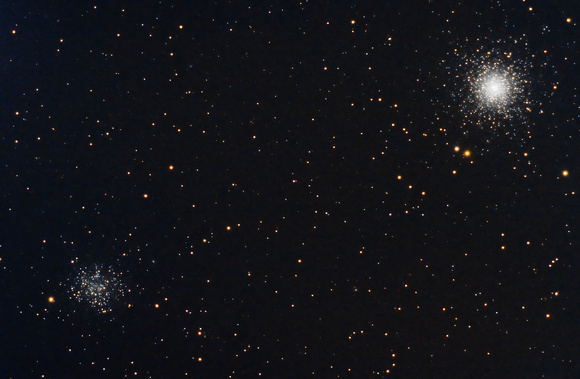Canon 350D Hap Griffin Baader Mod19x180sec at iso 1600
30 Darks/Flats/Bias
APM/TMB 130/780 Refractor with AP flattenerSky and Telescope Online Gallery May 23, 2008Yahoo Digital Astro Group April, 2008 Monthly Challenge Runner UpAstroimaging Challenge Yahoo Group Winner April, 2008
Globular star cluster M53 is one of the more outlying globulars, being about 60,000 light years away from the Galactic center, and almost the same distance (about 58,000 light years) from our Solar system. It's diameter is roughly 220 light years and it is rapidly approaching us at a velocity between 79 km/s and 112 km/s.
M53 has a bright compact central nucleus of about 2' in diameter, although its stars are not very concentrated toward the center when compared to other globulars. Its discoverer, Johann Elert Bode, who found it on February 3, 1775, described it as a "rather vivid and round" nebula. Charles Messier, who independently rediscovered and cataloged it two years later, on February 26, 1777, found it "round and conspicuous" and that it resembles M79. William Herschel was the first to resolve it into stars, and found it similar to M10.
As in all globular clusters, the stars of M53 are apparently "metal-poor", which means that they contain only little quantities of elements heavier than helium (actually mainly elements like carbon and oxygen); those of M53 are even below the average globular cluster members in "metallicity". It contains the considerably respectable number of 47 known RR Lyrae variables, some of them were reported to have changed their periods irreversibly with time (Kenneth Glyn-Jones).
At only about 1 degree separation to the east, the faint and quite loose globular cluster NGC 5053 comes into the field of view. NGC 5053 was discovered by William Herschel on March 14, 1784. NGC 5053 is at roughly the same distance as M53 (53,500 light years), indicating that these clusters are also physically rather close together. NGC 5053 is of a much lesser stellar density than its prominent neighbor, and particularly lacks a concentrated bright nucleus.
At a distance of about 53,500 light-years from us, NGC 5053's diameter is about 160 light-years. The cluster shines at a visual brightness of about 9.5 magnitudes. It is receding from us at about 44 km/s.
Because of its moderate stellar content, the nature of this cluster as a globular has been doubted in the past, but spectroscopic investigations have now firmly re-established this classification.
March 28, 2008


